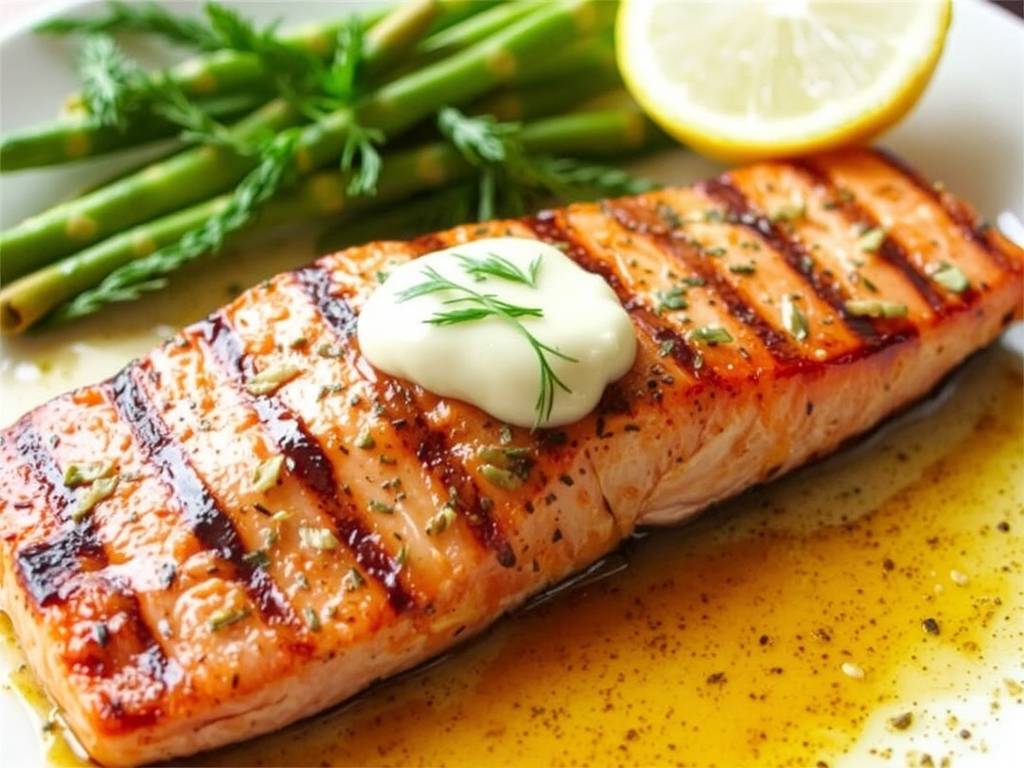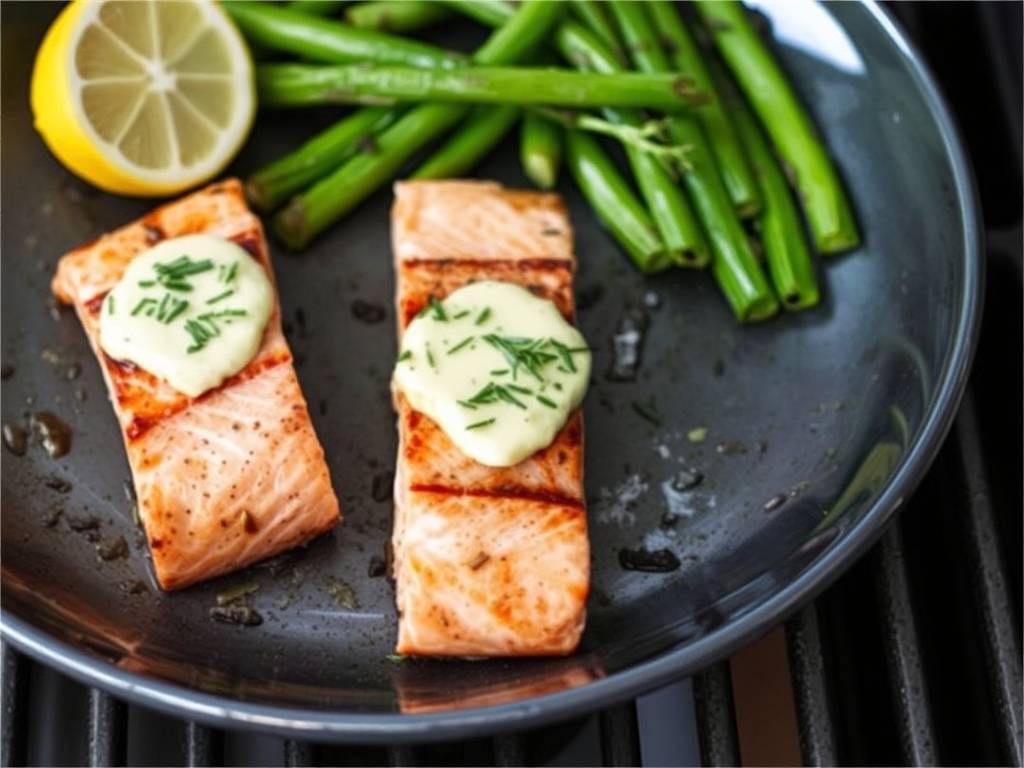The Art of Grilling Salmon with Dill and Lemon Butter: A Culinary Symphony

There is a certain magic that happens when the rich, oily flesh of salmon meets the intense, direct heat of a grill. The skin crackles and crisps, the interior becomes impossibly moist and flaky, and a subtle smokiness permeates every bite. While salmon is a culinary star in its own right, it finds its perfect harmony in a classic pairing: the bright, grassy notes of fresh dill and the rich, citrusy tang of lemon butter. This combination is more than a recipe; it's a celebration of simplicity and elegance, transforming a simple fillet into a gourmet experience. Mastering this dish requires an understanding of a few key principles: selecting the right salmon, preparing it with care, mastering grill technique, and crafting a sublime sauce that elevates the entire creation.
The Foundation: Choosing and Preparing Your Salmon

The journey to a perfect grilled salmon begins not at the grill, but at the market. The quality of your main ingredient is paramount. Look for fresh, wild-caught salmon varieties like King (Chinook), Sockeye, or Coho. Wild salmon tends to have a firmer texture and a more complex, robust flavor compared to its farmed counterpart. The flesh should be vibrant and glossy, spring back when pressed lightly, and smell cleanly of the sea, not fishy. If fresh, high-quality wild salmon is unavailable, high-grade frozen wild salmon is an excellent alternative, often flash-frozen at peak freshness.
When it comes to cuts, you have two primary options: individual fillets or a whole side of salmon. Fillelets, typically 6 to 8 ounces each, are easier to manage and cook quickly, making them ideal for weeknight dinners. A whole side, however, is a spectacular centerpiece for a gathering and can be more forgiving on the grill due to its larger mass. For this guide, we will focus on individual fillets, but the principles apply to a larger cut with adjusted cooking times.
Preparation is straightforward but crucial. Pat the salmon fillets completely dry with paper towels. This step is non-negotiable; moisture is the enemy of crispy skin. Next, inspect the fillets for any remaining pin bones. Run your fingers gently along the flesh; you may feel tiny, needle-like bones. Use a clean pair of needle-nose pliers or tweezers to pull them out in the direction they lie. This extra minute of effort ensures a pleasant, bone-free dining experience.
Now, for the first layer of flavor: a simple marinade or dry brine. While marinating in a liquid can be effective, for grilling, a dry brine or a light oil-based coating is superior. A dry brine—a light sprinkling of kosher salt on both sides of the fillet—left uncovered in the refrigerator for 30 minutes to an hour, will season the fish deeply and help draw out excess moisture, resulting in a firmer, more seasoned final product. Alternatively, a light coating of a neutral, high-heat oil like avocado or grapeseed oil will prevent sticking and promote browning. Season both sides generously with kosher salt and freshly ground black pepper.
The Heart of the Matter: The Dill and Lemon Butter Sauce
While the salmon grills, you will create the sauce that defines this dish. This is not a complicated reduction but an emulsion of simple, high-quality ingredients that sing in harmony. The star is unsalted butter. Using unsalted butter allows you to control the salt level precisely. You will need one stick (½ cup or 113 grams) of butter, cut into tablespoons for even melting.
In a small saucepan over low heat, melt the butter gently. You do not want to brown it; the goal is to just liquefy it. Meanwhile, zest one large lemon, taking care to avoid the bitter white pith. You should have about a tablespoon of bright, fragrant zest. Juice the same lemon until you have about two tablespoons of fresh juice. The acid is crucial for cutting through the richness of the salmon and butter.
Take a generous handful of fresh dill—dried dill is no substitute here. The fresh, almost anise-like flavor is essential. Chop it finely until you have about a quarter cup. To the melted, warm butter, add the lemon zest, lemon juice, and chopped dill. Whisk to combine. The acid from the lemon juice may cause the butter to seize slightly, but continuous whisking will create a cohesive, fragrant sauce. Season to taste with a pinch of salt and pepper. For an extra dimension, a small minced garlic clove can be gently sautéed in the butter before adding the other ingredients. Keep the sauce warm, but not hot, off the heat.
The Crucible: Mastering the Grill
Grilling salmon can be intimidating. Its delicate flesh has a tendency to stick and fall apart. The key is high heat, a clean grill, and patience. Whether using a gas or charcoal grill, your target is medium-high to high heat (around 400-450°F or 200-230°C). A properly preheated grill is your best defense against sticking.
Start with a impeccably clean grill grate. Once the grill is hot, use a sturdy grill brush to scrub the grates clean. Then, the most important step: oil the grates. Fold a paper towel into a small pad, dip it in a high-heat oil (like avocado or canola), and, using tongs, carefully wipe it over the hot grates. This creates a non-stick surface.
Now, for the moment of truth. Place the salmon fillets skin-side down on the hot grill at a 45-degree angle to the grates. This positioning gives you attractive grill marks and makes flipping easier. Here is the critical rule: do not move the fish. Close the lid and let it cook. The skin will begin to crisp and release from the grates naturally. Depending on the thickness of your fillets, this will take 4 to 8 minutes. You are looking for the flesh to become opaque about two-thirds of the way up the sides of the fillet.
Flipping salmon is a delicate operation. Use a thin, wide, flexible metal spatula. Slide it carefully but confidently under the fish. If it resists, it is not ready to flip; give it another minute. A properly seared fillet will release easily. Flip the salmon and cook for just 1 to 3 minutes on the flesh side, just long enough to finish cooking through. The goal is to avoid overcooking the second side. For those who prefer not to flip, you can cook the salmon entirely skin-side down with the lid closed. This is a foolproof method for achieving crispy skin and evenly cooked flesh, though you will miss the grill marks on top.
How do you know when it's done? The FDA recommends an internal temperature of 145°F (63°C), but many chefs and home cooks prefer to pull it off the grill at around 125-130°F (52-54°C) for a medium doneness. The salmon will be opaque and flake easily with a fork at the thickest part, but still remain incredibly moist. Remember, carryover cooking will continue after you remove it from the heat.
The Grand Finale: Plating and Serving
The final act is about bringing all the elements together. Carefully transfer the grilled salmon to a warm platter or individual plates. Immediately spoon the warm dill and lemon butter sauce generously over the top. The residual heat from the salmon will awaken the aromas of the dill and lemon.
This dish deserves complementary sides that won't overpower it. Consider simple grilled asparagus or zucchini, a light quinoa salad with herbs, or creamy mashed potatoes that act as a perfect canvas for the extra sauce. A wedge of lemon on the side allows guests to add an extra burst of freshness if desired.
Grilling salmon with dill and lemon butter is more than following steps; it's an exercise in balancing flavors and textures. It’s about the sizzle as the fillet hits the grate, the aroma of dill and citrus mingling with wood smoke, and the final, satisfying flake of a perfectly cooked piece of fish. It is a testament to the fact that the most memorable meals often come from the simplest, highest-quality ingredients, treated with respect and a little bit of culinary fire.






发表评论